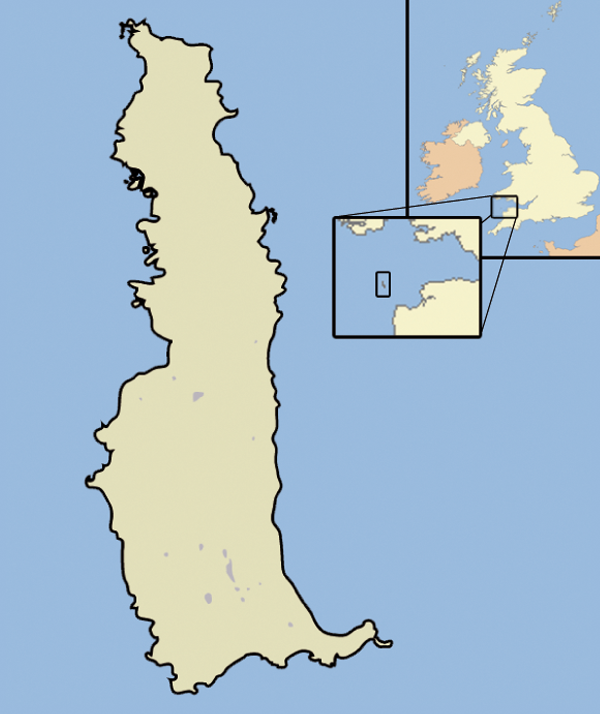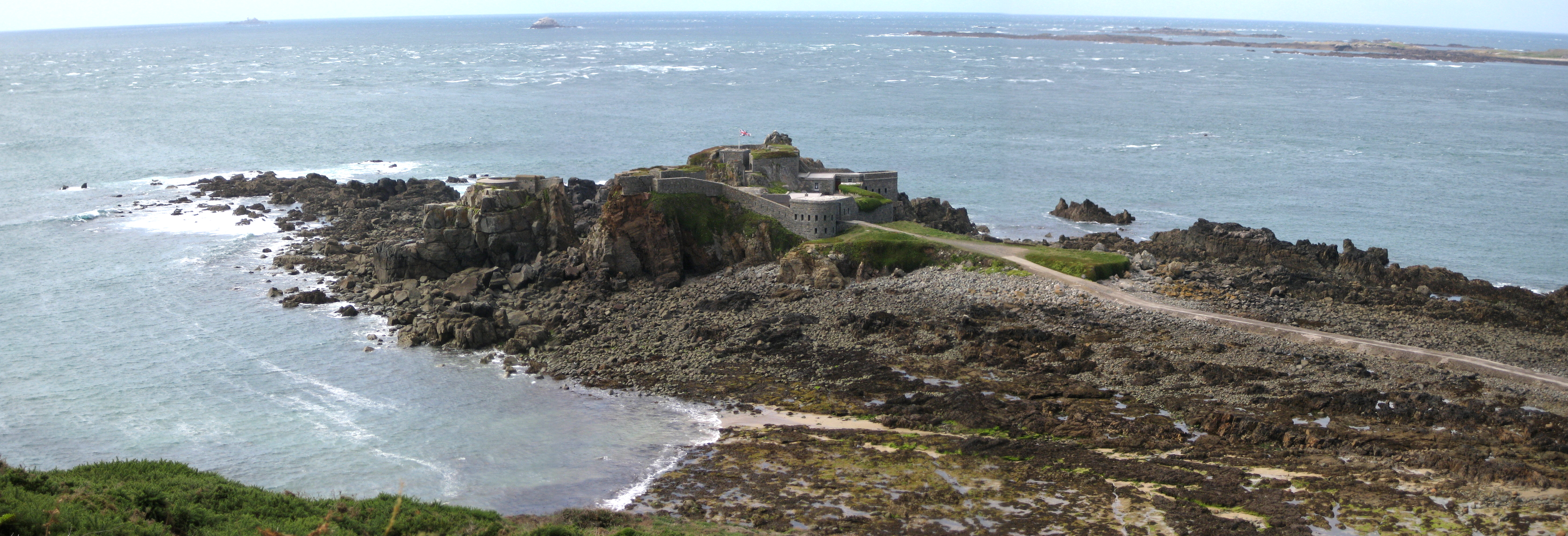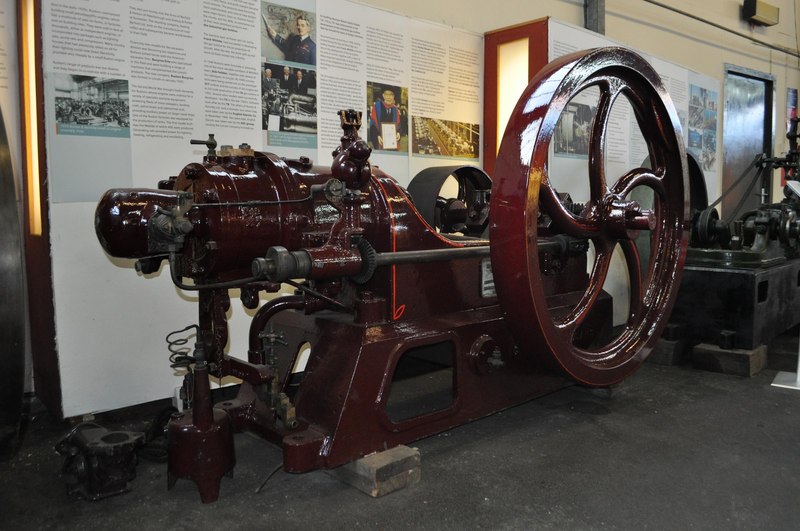|
Lundy North Lighthouse
The isle of Lundy has three lighthouses: a pair of active lights built in 1897 and an older lighthouse dating from 1797. Old light Foundations for a lighthouse on Lundy were laid in 1787, but the first lighthouse (now known as the Old Light) was not built until Trinity House obtained a 999-year lease in 1819. The granite tower, on the summit of Chapel Hill, was designed by Daniel Asher Alexander, and built by Joseph Nelson at a cost of £36,000. Because the site, Beacon Hill, is above sea level, the highest base for a lighthouse in Britain, the light was often obscured by fog. To counter this problem, a Fog Signal Battery, equipped with a pair of 18-pound guns, was built about 1861; guncotton rockets replaced these fog signal guns in 1878. The lighthouse had two lights: the lower a fixed white light and the upper a quick flashing white light, showing every 60 seconds (both lights were provided by Argand lamps fitted with parabolic reflectors). The flashing characteristic was an ... [...More Info...] [...Related Items...] OR: [Wikipedia] [Google] [Baidu] |
Lundy
Lundy is an English island in the Bristol Channel. It was a micronation from 1925–1969. It forms part of the district of Torridge in the county of Devon. About long and wide, Lundy has had a long and turbulent history, frequently changing hands between the British crown and various usurpers. In the 1920s, one self-proclaimed king, Martin Harman, tried to issue his own coinage and was fined by the House of Lords. In 1941, two German Heinkel He 111 bombers crash landed on the island, and their crews were captured. In 1969, Lundy was purchased by British millionaire Jack Hayward, who donated it to the National Trust. It is now managed by the Landmark Trust, a conservation charity that derives its income from day trips and holiday lettings, most visitors arriving by boat from Bideford or Ilfracombe. A local tourist curiosity is the special "Puffin" postage stamp, a category known by philatelists as "local carriage labels", a collectors' item. As a steep, rocky island ... [...More Info...] [...Related Items...] OR: [Wikipedia] [Google] [Baidu] |
Landmark Trust
The Landmark Trust is a British building conservation charity, founded in 1965 by Sir John and Lady Smith, that rescues buildings of historic interest or architectural merit and then makes them available for holiday rental. The Trust's headquarters is at Shottesbrooke in Berkshire. Most Trust properties are in England, Scotland and Wales. Several are on Lundy Island off the coast of north Devon, operated under lease from the National Trust. In continental Europe there are Landmark sites in Belgium, France and Italy. Five properties are in the United States — all in Vermont — one of which, Naulakha, was the home of Rudyard Kipling in the 1890s. The Trust is a charity registered in England & Wales and in Scotland. The American sites are owned by an independent sister charity, Landmark Trust USA. There is also an Irish Landmark Trust. Those who rent Landmarks provide a source of funds to support restoration costs and building maintenance. The first rentals were in 1967 when ... [...More Info...] [...Related Items...] OR: [Wikipedia] [Google] [Baidu] |
Fourth Order Fresnel Lens
A Fresnel lens ( ; ; or ) is a type of composite compact lens developed by the French physicist Augustin-Jean Fresnel (1788–1827) for use in lighthouses. It has been called "the invention that saved a million ships." The design allows the construction of lenses of large aperture and short focal length without the mass and volume of material that would be required by a lens of conventional design. A Fresnel lens can be made much thinner than a comparable conventional lens, in some cases taking the form of a flat sheet. The simpler dioptric (purely refractive) form of the lens was first proposed by Count Buffon and independently reinvented by Fresnel. The ''catadioptric'' form of the lens, entirely invented by Fresnel, has outer elements that use total internal reflection as well as refraction; it can capture more oblique light from a light source and add it to the beam of a lighthouse, making the light visible from greater distances. Description The Fresnel lens reduce ... [...More Info...] [...Related Items...] OR: [Wikipedia] [Google] [Baidu] |
Gas-discharge Lamp
Gas-discharge lamps are a family of artificial light sources that generate light by sending an electric discharge through an ionized gas, a plasma. Typically, such lamps use a noble gas (argon, neon, krypton, and xenon) or a mixture of these gases. Some include additional substances, like mercury, sodium, and metal halides, which are vaporized during startup to become part of the gas mixture. Single ended self-starting lamps are insulated with a mica disc and contained in a borosilicate glass gas discharge tube (arc tube) and a metal cap. They include the sodium-vapor lamp that is the gas-discharge lamp in street lighting. In operation, some of the electrons are forced to leave the atoms of the gas near the anode by the electric field applied between the two electrodes, leaving these atoms positively ionized. The free electrons thus released flow onto the anode, while the cations thus formed are accelerated by the electric field and flow towards the cathode. Typicall ... [...More Info...] [...Related Items...] OR: [Wikipedia] [Google] [Baidu] |
Tannoy
Tannoy is a British manufacturer of loudspeakers and public address systems. Founded by Guy Fountain in London in 1926 as the Tulsemere Manufacturing Company, today the company is part of the Music Tribe group of brands. History Tannoy Ltd is a British manufacturer of loudspeakers and public address (PA) systems. The company was founded by Guy Fountain in London, England, as Tulsemere Manufacturing Company in 1926, and moved to Coatbridge, Scotland in the 1970s. Tannoy's image is particularly linked to both studio monitors as well as its Prestige range of home speakers. Prestige speakers use Dual Concentric cone speakers and are easily recognisable by their "vintage" design. Tannoy is notable for its 'Dual Concentric' speaker design, which places the tweeter behind the centre of the medium or bass driver. "Dual Concentric" is a trademark although Tannoy is not the only speaker manufacturer to design coaxial speakers. In 2002, Tannoy was acquired by TC Group, and TC Group was s ... [...More Info...] [...Related Items...] OR: [Wikipedia] [Google] [Baidu] |
Ruston & Hornsby
Ruston & Hornsby was an industrial equipment manufacturer in Lincoln, Lincolnshire, Lincoln, England founded in 1918. The company is best known as a manufacturer of narrow gauge railway, narrow and standard gauge diesel locomotives and also of steam shovels. Other products included automobile, cars, steam locomotives and a range of internal combustion engines, and later gas turbines. It is now a subsidiary of Siemens. Background Proctor & Burton was established in 1840, operating as millwrights and engineers. It became Ruston, Proctor and Company in 1857 when Joseph Ruston joined them, acquiring limited liability status in 1899. From 1866 it built a number of four and six-coupled tank locomotives, one of which was sent to the Exposition Universelle (1867), Paris Exhibition in 1867. In 1868 it built five 0-6-0 tank engines for the Great Eastern Railway to the design of Samuel Waite Johnson. Three of these were converted to crane tanks, two of which lasted until 1952, aged eighty ... [...More Info...] [...Related Items...] OR: [Wikipedia] [Google] [Baidu] |
L Gardner & Sons
L. Gardner and Sons Ltd was a British builder of diesel engines for stationary, marine, road and rail applications. The company was founded in Hulme, Manchester, England in 1868. It started building engines around 1895. The firm ceased engine production in the mid-1990s. Origin About 1868 Lawrence Gardner set up as a sewing machine maker in Upper Duke Street, Stretford Road, Hulme, Manchester. He died in 1890, but the business was continued by his sons under the name L. Gardner & Sons Ltd. Gas and diesel engines From about 1895 the company was building gas engines and, in 1899 it moved into Barton Hall Engine Works, Patricroft, Manchester. In 1903 it became a limited company, L Gardner and Sons Ltd. Norris and Henty Ltd, of London, were appointed as sales agents. Diesel engine production began in around 1903. In 1912 a new sales subsidiary, Norris, Henty and Gardners Ltd, was formed. During World War I (1914–1918) the company made munitions and parts for heavy guns and en ... [...More Info...] [...Related Items...] OR: [Wikipedia] [Google] [Baidu] |
Acoustic Horn
An acoustic horn or waveguide is a tapered sound guide designed to provide an acoustic impedance match between a sound source and free air. This has the effect of maximizing the efficiency with which sound waves from the particular source are transferred to the air. Conversely, a horn can be used at the receiving end to optimize the transfer of sound from the air to a receiver. Acoustic horns are found in nature in the form of the burrows constructed by male mole crickets to amplify their song. The earliest appearance of the horn in connection to sound in The Times was published in 1786: Applications Acoustic horns are used in: * horn loudspeakers * brass and woodwind musical instruments * vehicle horns such as those used on cars, trucks, trains, boats, and bicycles * megaphones, often used by lifeguards at public swimming pools. * foghorns, used to warn ships * ear horns, used by people who are hard of hearing (the human ear itself having the form of a horn) * pickup horns, ... [...More Info...] [...Related Items...] OR: [Wikipedia] [Google] [Baidu] |
Hornsby-Akroyd Oil Engine
The Hornsby-Akroyd oil engine, named after its inventor Herbert Akroyd Stuart and the manufacturer Richard Hornsby & Sons, was the first successful design of an internal combustion engine using heavy oil as a fuel. It was the first to use a separate vapourising combustion chamber and is the forerunner of all hot-bulb engines, which are considered predecessors of the similar Diesel engine, developed a few years later. Early internal combustion engines were quite successful running on gaseous and light petroleum fuels. However, due to the dangerous nature of petroleum and light petroleum fuel, legal restrictions were placed on their transportation and storage. Heavier petroleum fuels, such as kerosene, were quite prevalent, as they were used for lighting, but posed specific problems when used in internal combustion engines: Oil used for engine fuel must be turned to a vapour state and remain in that state during compression. Furthermore, the combustion of the fuel must be powerf ... [...More Info...] [...Related Items...] OR: [Wikipedia] [Google] [Baidu] |
Siren (alarm)
A siren is a loud noise-making device. Civil defense sirens are mounted in fixed locations and used to warn of natural disasters or attacks. Sirens are used on emergency service vehicles such as ambulances, police cars, and fire engines. There are two general types: mechanical and electronic. Many fire sirens (used for calling the volunteer fire fighters) serve double duty as tornado or civil defense sirens, alerting an entire community of impending danger. Most fire sirens are either mounted on the roof of a fire station or on a pole next to the fire station. Fire sirens can also be mounted on or near government buildings, on tall structures such as water towers, as well as in systems where several sirens are distributed around a town for better sound coverage. Most fire sirens are single tone and mechanically driven by electric motors with a rotor attached to the shaft. Some newer sirens are electronically driven speakers. Fire sirens are often called "fire whistles", "fir ... [...More Info...] [...Related Items...] OR: [Wikipedia] [Google] [Baidu] |
Light Characteristic
A light characteristic is all of the properties that make a particular navigational light identifiable. Graphical and textual descriptions of navigational light sequences and colours are displayed on nautical charts and in Light Lists with the chart symbol for a lighthouse, lightvessel, buoy or sea mark with a light on it. Different lights use different colours, frequencies and light patterns, so mariners can identify which light they are seeing. Abbreviations While light characteristics can be described in prose, e.g. "Flashing white every three seconds", lists of lights and navigation chart annotations use abbreviations. The abbreviation notation is slightly different from one light list to another, with dots added or removed, but it usually follows a pattern similar to the following (see the chart to the right for examples). * An abbreviation of the type of light, e.g. "Fl." for flashing, "F." for fixed. * The color of the light, e.g. "W" for white, "G" for green, "R" for red, ... [...More Info...] [...Related Items...] OR: [Wikipedia] [Google] [Baidu] |
1911 Encyclopædia Britannica/Lighthouse
A notable ongoing event was the race for the South Pole. Events January * January 1 – A decade after federation, the Northern Territory and the Australian Capital Territory are added to the Commonwealth of Australia. * January 3 ** 1911 Kebin earthquake: An earthquake of 7.7 moment magnitude strikes near Almaty in Russian Turkestan, killing 450 or more people. ** Siege of Sidney Street in London: Two Latvian anarchists die, after a seven-hour siege against a combined police and military force. Home Secretary Winston Churchill arrives to oversee events. * January 5 – Egypt's Zamalek SC is founded as a general sports and Association football club by Belgian lawyer George Merzbach as Qasr El Nile Club. * January 14 – Roald Amundsen's South Pole expedition makes landfall, on the eastern edge of the Ross Ice Shelf. * January 18 – Eugene B. Ely lands on the deck of the USS ''Pennsylvania'' stationed in San Francisco harbor, the ... [...More Info...] [...Related Items...] OR: [Wikipedia] [Google] [Baidu] |










